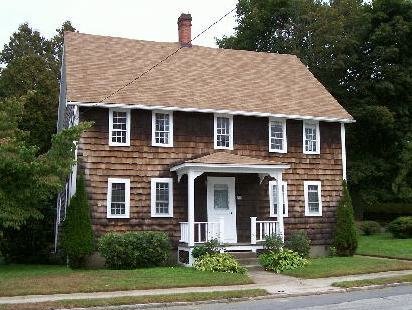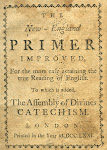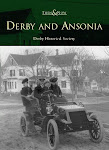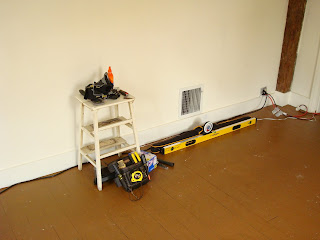The first map, City of Derby, Connecticut, was published by Hughes and Bailey in 1920. While its illustrations are not necessarily drawn to scale, this map reveals a remarkable amount of information about the town, its streets, its buildings, and their relationships to one another.

Hughes and Bailey's "City of Derby, Connecticut" illustrated map (source: Library of Congress)
When I zoomed-in on the intersection of Hawkins Street and Seymour Avenue, I found a surprisingly detailed rendering of the Hawkins house. In the expanded illustration below, it is right at dead-center of the image. The house appears to be drawn largely out of scale with regard to most of the neighboring houses and other features, and I can not readily account for why it was drawn in this manner. The fact that the house originally stood on a large, raised foundation might have skewed the artist's perspective, while another possibility is that the artist considered it a significant landmark, and drew it out of scale to emphasize it as such.

Close-up of Hughes and Bailey's "City of Derby, Connecticut" map, showing the vicinity of the intersection of Hawkins Street and Seymour Avenue (source: Library of Congress)
Zooming even closer in on the house revealed a number of its most prominent features. The large center chimney is there, and is represented as being slightly offset from the ridge line, toward the back of the house. I know that this had, in fact, been the case, as it's obvious from the roof system in the attic. The raised foundation is also captured in the illustration, as are the three descending windows on the first floor of the south end.

Zooming further in on Hughes and Bailey's "City of Derby, Connecticut" map reveals an accurately detailed image of the Hawkins house (source: Library of Congress)
Finally, the three old homes directly across the street are also shown, with fairly reasonable spatial relationships to my home. The only significant error in this rendering is that the artist appears to have included a third window on the second floor of the south end, whereas in reality, there are only two.
The other map, published by Landis and Hughes, and entitled Derby & Shelton, East Derby, Conn. 1898, is shown below, with a red rectangle delineating the area of the intersection of Hawkins Street and Seymour Avenue.

Landis and Hughes' "Derby & Shelton, East Derby, Conn. 1898" illustrated map (source: Library of Congress)
Zooming-in on Hawkins Street reveals what appears to be the Hawkins house correctly situated between Tenth and Eleventh Streets, and generally in correct relation to the same three old homes on the opposite side of the street. However, the representations of the buildings themselves are rather boilerplate and lack any significant detail.

Close-up of Landis and Hughes' "Derby & Shelton, East Derby, Conn. 1898" map, showing Hawkins, Tenth, and Eventh Streets (source: Library of Congress)
My discovery of these illustrations -- the Hughes and Bailey map, primarily -- is significant in the sense that it tightens up a loose end in the history of the house; namely, the exact location of the original home site. While it is generally accepted that the house was moved to its current location in the 1950s to avoid the wrecking ball during the construction of Connecticut Route 8, there had always been some uncertainty as to where the house actually came from.
Although it had always ostensibly been associated with Hawkins Street (Samuel Orcutt's History of The Olde Town of Derby, for example, often states this to be the case), several nineteenth century cartographers failed to accurately record the location of the house on scaled maps. And, perhaps as a result of this, more recent architectural surveys of Derby missed the house entirely. This situation is, in fact, described in a Derby Historical Society article published just a few years ago. However, the Hughes and Bailey map strongly suggests that the present-day Hawkins Street location is also the original seventeenth century home site.
Right after discovering this, I thought: If this is the original site, then what traces of the old foundation might yet remain? And it suddenly struck me that I'd been staring at the old foundation all along, in the outline of the somewhat odd, modern concrete pavement currently surrounding the south-end and back of the house. It just never had occurred to me before that moment.


Above left: The ca. 1939 photo of the Hawkins house, with raised foundation extending out beyond the back of the house, a stone staircase, and an overhead awning where the mudroom is now located. Above right: The modern stonework surrounding the south end and back of the house appears to conform exactly to the outline of the previous raised foundation.
As you can see from the two photos shown above, the modern stonework aligns perfectly with the grade-level footprint of the old raised foundation. And the peculiar "landing from nowhere" abutting the concrete slab in the photo on the right almost certainly appears to have been the base of the old stone staircase shown in the 1939 photo on the left. My guess is that these modern concrete slabs are actually capping a large number of old dry-laid stones that had comprised the lowest-level courses of the original foundation.
So, my conclusion is that the Hawkins house had been re-situated at its original site when it was moved in the 1950s. Not only is this conclusion supported by physical evidence, but it is also consistent with claims by contemporary Gaynor-Farrell family descendants that my home had, in fact, been moved twice during the 1940s-1950s, with the first move relocating it to a point on Hawkins Street that today is somewhere within the vicinity of the east abutment of the Hawkins Street bridge. While the exact reason for moving the house to that particular location is not well-remembered, the location itself is still strongly upheld as such by the Gaynor-Farrell family.
Clearly, the second move of the 1950s simply returned the house to the location from whence it originally came, albeit to a modern foundation of concrete blocks constructed within the confines of what had been the old foundation, with most of the original, dry-laid stones having long been removed and taken away.
For a related article, see The Old Hawkins House.
Postscript
Since publishing this article, I've discovered yet another illustrated map of Derby, entitled Birmingham, Conn. 1876. The particular rendering of this map that I initially came across is printed on p. 6 of the Derby Historical Society's Images of America: Derby (Arcadia Publishing, 1999), and carries the label "Wilkinson Brothers & Co., Derby Paper Mills."
However, Randy Ritter, of the Derby Historical Society, informed me that the map had been created by O. H. Bailey, and that an online copy is maintained by the Norman B. Leventhal Map Center of the Boston Public Library. The 1876 map is shown below (and many thanks to Randy for the link).

Bailey's "Birmingham, Conn. 1876" illustrated map, with a red rectangle pin-pointing the location of the Hawkins house and surrounding homes (source: Boston Public Library)
Zooming-in on the vicinity of Hawkins Street reveals the Hawkins house and the various surrounding homes and structures. It's interesting to note that the large colonial house with double-ended chimneys that today sits directly across the street from the Hawkins house had not yet been built in 1876. This house is, however, represented in both the 1898 and 1920 maps.

Close-up of Bailey's "Birmingham, Conn. 1876" map, showing the Hawkins house and adjacent homes (source: Boston Public Library)
Another interesting aspect of the 1876 map is that it illustrates the gentle dip of land that once existed just behind the Hawkins house. Today, Connecticut Route 8 cuts through this area, just where the dip begins to drop more steeply (as shown in the old illustration), as a considerable amount of the original land behind the Hawkins house had been excavated away.
According to my neighbor Gary Farrell, his uncle, Len Gaynor, had had a herd of cows grazing on this land, as recently as the early 1950s. An old cow shed and stone wall still exist behind Gary's house, the only surviving remnants of those earlier times.

























